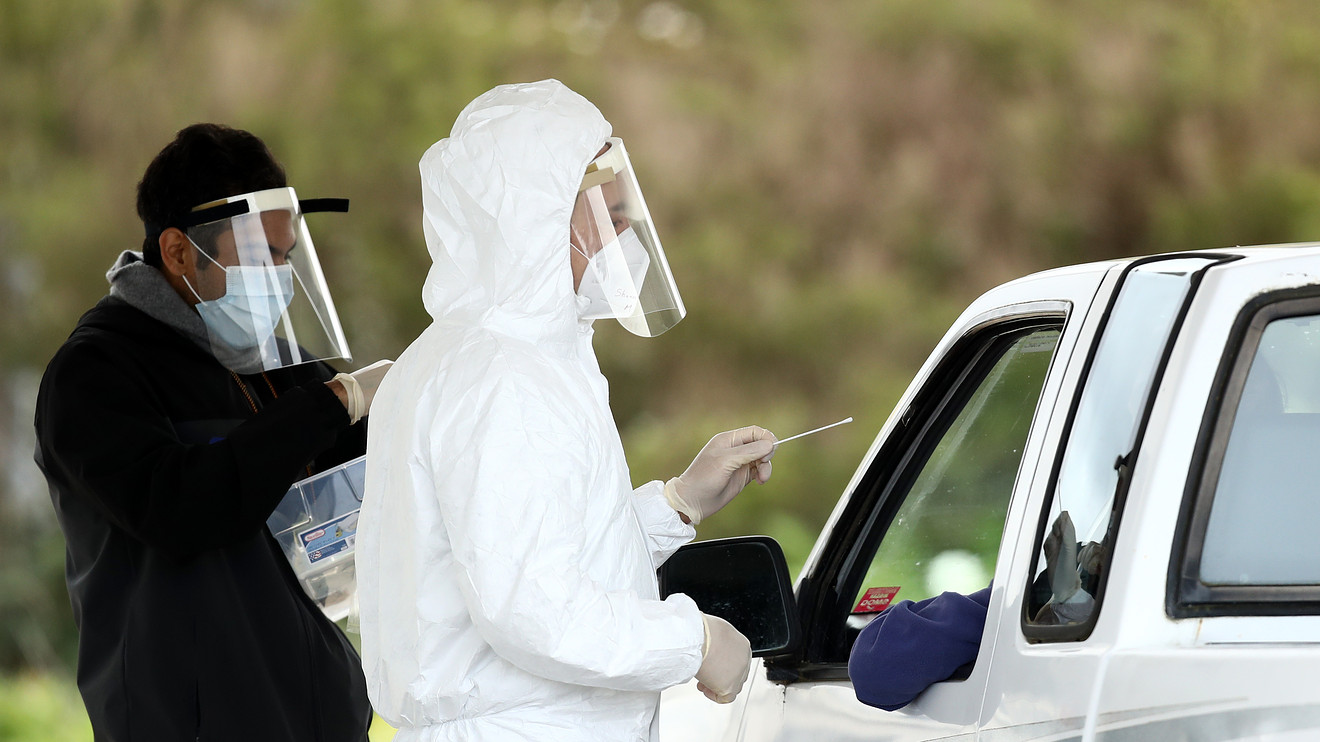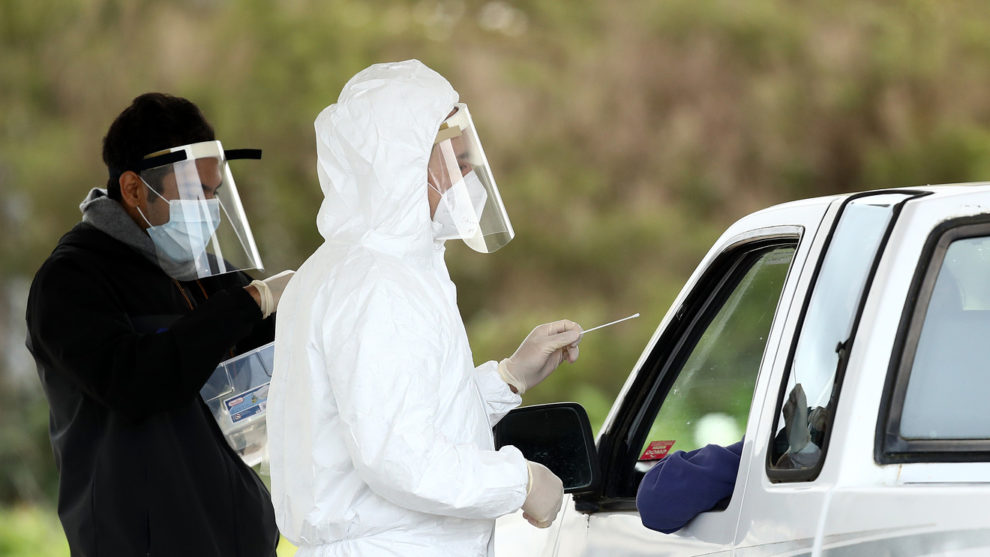
There are still unanswered questions about the accuracy of some COVID-19 tests, the prevalence of antibodies among Americans, and whether those antibodies provide the kind of immunity safety net needed to protect people from future infection.
A new report from Harvard University’s Edmond J. Safra Center for Ethics calls for five million COVID-19 tests a day by early June and up to 20 million a day by late July “to fully remobilize the economy.” Those figures are in contrast to the roughly four million tests in total that have been conducted in the U.S. since the first stateside case of the novel coronavirus was identified in late January. (That also means that four million tests have been conducted, not that four million people have been tested, experts say.)
“Testing is the only way to get back to a semblance of normalcy,” said Alex Tabarrok, an economist at George Mason University and co-author of the report.
Read: CDC director warns second wave of coronavirus could be even worse
Cowen analysts expect the largest diagnostics companies to produce 30 million diagnostics tests per month by the end of June. Including serological tests, that would be 50 million tests a month by the end of the second quarter. While those estimates are likely sufficient for what is included in clinical settings, they don’t take into account “broad employer screening.”
More than 825,000 Americans have tested positive for COVID-19 and at least 45,000 people have died, according to data aggregated by Johns Hopkins University.
The testing process for COVID-19 in the U.S. has been troubled from the start. The test kits designed and shipped by the Centers for Disease Control and Prevention (CDC) in early February to public health laboratories had flawed components that “may be the result of a design and/or manufacturing issue or possible contamination,” a CDC spokesperson said in an email. The Department of Health and Human Services, which oversees the CDC, is conducting an assessment, he added.
There are also a number of scientific unknowns and technological limitations about the diagnostic and serologic testing being used in the three months since the first U.S. case was detected. For example, people who know they were exposed to the virus and have contracted it may still get a negative result if they are tested too soon. Separately, serological tests that reveal a past infection may indicate immunity to future infections, but it is unclear at this time how long that immunity lasts or to what degree it can protect someone.
“It’s important for everyone to understand that the timing of the response of the antibody to the infection isn’t completely known, but we know that it takes some time to actually develop that,” Food and Drug Administration (FDA) commissioner Dr. Stephen Hahn said Tuesday.
See also: Nurse in NYC shares what it’s like to test people for the coronavirus
Among the other issues cited by Tabarrok: the nasal swabs used to collect samples often cause people to sneeze, which can put the health care workers doing the testing at higher risk of exposure to the virus. That’s created additional demand for personal protective equipment like gowns, masks, and gloves. Tests should be processed and an individual notified of the results within 12 to 24 hours, which hasn’t always been the case, to prevent infection among an individual’s friends, family members, or co-workers.
The longer-term solutions to some of these problems include the creation of saliva test kits, mass testing centers and deposit boxes to drop off the saliva samples, and a workforce of 100,000 contract tracers, according to Tabarrok. Employers and churches may need to operate their own testing machines.
In fact, a new process is under way at Walmart Inc. WMT, +1.57% testing sites. Individuals drive in, receive a swab from a health care worker, roll up the car window, and that worker observes them using the nasal swab themselves to collect the sample, according to comments made by Quest Diagnostics Inc. DGX, +5.01% CEO Steve Rusckowski during an earnings call on Wednesday. “That’s proven to be highly efficient, and we’re looking at other ways of collecting that front-end on molecular side,” he said, according to a FactSet transcript of the call.
Do the tests work?
That depends on whom you talk to and the test in question.
At least 39 labs including the CDC, Hologic Inc. HOLX, +1.62%, and Thermo Fisher Scientific Inc. TMO, +4.83% have received emergency use authorizations (EUA) from the FDA to market their COVID-19 diagnostic tests.
Four organizations — the privately held companies Cellex Inc. and Ortho-Clinical Diagnostics Inc., Chembio Diagnostics Inc. CEMI, -1.95%, and the Mount Sinai Laboratory — have been authorized to market their antibody tests, though more than 70 others have notified the FDA that they are selling antibody tests, which is allowed as a result of changes to the traditional FDA regulatory process during the pandemic.
However, the Los Angeles County Department of Public Health on Tuesday informed laboratories to only report results from serologic tests that have been granted an EUA, noting the possibility of false negative and false positive results and that some companies may be making false claims that their tests are authorized or approved by the FDA. In addition, antibody tests cannot diagnose an active infection so they can’t be used to rule out an infection with the virus.
These are concerns also raised by Wall Street analysts. “Extremely high demands for such serology assays in the midst of FDA’s very generous and approving EUA guidelines is risking the market being flooded by low performing assays that hold the potential to deliver inadequate results and misdirect public health efforts,” SVB Leerink analysts said April 20.
At the same time, antibody testing has been called a “game-changer” in efforts to safety reopen the economy.
New York Gov. Andrew Cuomo has been especially bullish on the role widespread antibody testing can play in hard-hit New York, which has reported one-third of COVID-19 deaths in the U.S. “We’re going to do that in the most aggressive way in the nation where we’re going to sample people in this state, thousands of people in this state, across the state to find out if they have the antibodies,” he said Sunday during a news conference. “That will tell us for the first time what percent of the population actually has had the coronavirus and is now, at least short-term, immune to the virus.”
What we’re learning about the prevalence of COVID-19 antibodies
A wave of regional research projects that were unveiled this week indicate that the percentage of people with COVID-19 antibodies is much higher than had been expected. None of this research has been peer reviewed; it is either a preprint, meaning it doesn’t have the same gravitas as a peer-reviewed medical study and is not supposed to be used to inform medical decision making, or correspondence from clinicians.
• In Santa Clara County in Northern California, 1.5% of the 3,330 people tested for antibodies during a two-day period in April had them, according to a preprint published April 11 by Stanford University researchers. “After adjusting for population and test performance characteristics, we estimate that the seroprevalence of antibodies to SARS-CoV-2 in Santa Clara County is between 2.49% and 4.16%,” they wrote.
• Using the first round of data from a continuing antibody testing study in Los Angeles County, researchers there now estimate that about 4% of adults have antibodies, which translates to somewhere between 221,000 and 442,000 people. That’s a significantly higher figure than the 7,994 cases that had been reported to the county on April 10 and 11, when the antibody tests were conducted. It may also mean the risk of death is lower. The county is using an antibody test designed by Premier Biotech that reportedly has a 90% to 95% accuracy rate.
• Between March 22 and April 4, 215 pregnant women who gave birth at New York–Presbyterian Allen Hospital or Columbia University Irving Medical Center were screened for COVID-19. Four symptomatic women tested positive for the virus; 29 women who didn’t have symptoms also tested positive. “The true prevalence of infection may be under-reported because of false negative results of tests to detect” COVID-19, four physicians wrote in an April 13 letter to The New England Journal of Medicine.
• More data may emerge from other citywide testing programs. The town of Bolinas, Calif., raised $90,000 out of a $250,000 goal through GoFundMe to test every resident in the small Northern California beach community over a three-day period this week. Fisher Island in Miami is reportedly testing all residents and staffers, as is Colorado’s San Miguel County.
A short-term, billion-dollar opportunity for diagnostics companies
Analysts predict billions of dollars in sales over the next few years for the sector. If the U.S. and Europe used 85 million tests by August 4 and 20 million in the U.S. through next winter, that is a $3 billion market, Cowen analysts estimated.
A few big-name diagnostics companies like Abbott Laboratories ABT, +1.06%, Roche Holding AG ROG, +2.66% and Quest Diagnostics Inc. DGX, +5.01% have developed both molecular and serological tests, while Laboratory Corporation of America Holdings LH, +3.25% on Tuesday announced the first at-home test kit for frontline workers, including those working in health-care settings who are at risk of contracting the virus.
Read: These experimental drugs may help keep COVID-19 patients off ventilators
During its first-quarter earnings call on Wednesday, Quest executives told investors that the company has performed nearly 1 million tests and is conducting about 50,000 diagnostic tests a day.
For Abbott, which has launched three tests (two are lab-based and one is point-of-care) and has two more in development, Credit Suisse analysts expect $50 million in sales of diagnostic tests and $550 million in sales of serological tests in 2021. Abbott’s test is thought to cost around $5 per test. “We view this wave of new tests as a significant new growth driver for ABT over the next two to three years,” they wrote April 17.
J.P. Morgan analysts predict Roche’s serology test, which they expect to be available in early May, could add up to $285 million a month to its diagnostics business if the test is priced at $3 a piece. “With COVID-19 concern and testing requirement likely to persist at least until the end of year, this could provide around $1.7 billion of revenue for Roche Diagnostics providing Roche sell all of their testing capacity from July onward,” they wrote in an April 16 note.
Year-to-date, Abbott’s stock is up 9.6%, shares of Quest are down 8.5%, Roche’s stock has gained 9.3%, and LabCorp’s stock has tumbled 10.9%.
The S&P 500 SPX, +2.14% has dropped 15.3% since the start of the year.











Add Comment